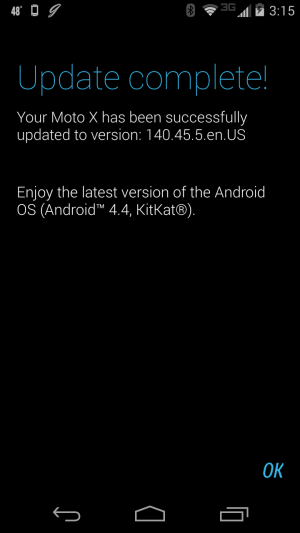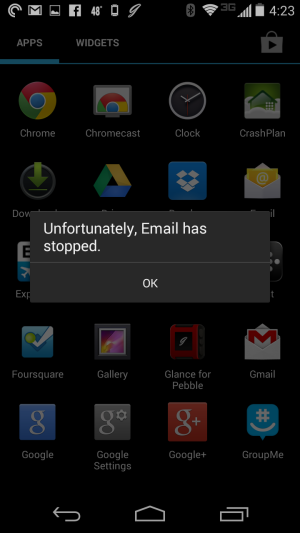
Nineteen days. That’s how long it took Motorola to update its flagship Android handset, the Moto X, to KitKat, the latest version of Google's mobile operating system. Among Android handset makers, that's as astonishing an accomplishment as breaking the four-minute mile. And it comes, no less, on a carrier not known for speedy software updates: Verizon Wireless.
The update came through on my personal Moto X just a few hours after news of the update was revealed, and we were eager to see how Motorola's build of KitKat would differ from the Nexus 5 and the other supported Nexus devices. It turns out that despite all the changes, not much has changed.
Motorola, a Google company, originally took a light touch visually with its Android 4.3 build on the Moto X, and the 4.4 build is just as conservative. The many visual tweaks to Android’s interface remain intact, with gray as the predominant shade. Basic OS elements like fonts, organization, and notifications remain consistent between the Nexus and Moto X builds.
Translucency effects are inconsistently applied across KitKat, including on the Moto X. This is most noticeable in the transition from the home screen to an app with a light background, as the translucent background changes to an opaque black. As noted in our KitKat review, Google has demonstrated a more consistent application of these effects in all sorts of apps, but complete consistency seems destined for a future update. Whether the change comes at the system level or through updates to individual apps, it can't come soon enough.
-
Mmmmm... translucent.
-
Ugh. Opaque.
-
Even the lock screen gets in on layering.
Opening the Phone app brings up the new search-optimized dialer and raises the QWERTY keyboard, not the dial pad. If you only call people in your contacts this is no issue. Want to dial an actual number? You’ll have a few extra key presses to make that happen.
-
Hmm... where's the dialpad?
-
Oh, what's that?
-
Ahh, there it is.
Of the Ars staffers with personal Android gear, I was the first to perform an in-place update to Android 4.4 rather than wiping the device first and performing a clean install. The process wasn’t without its issues. Once the update had completed, the Email app crashed repeatedly. The only remedy was to delete my Exchange account from the Settings app and then re-enter the account information through the (now stable) Email app. I spoke with Motorola’s dev team, and they suspect that a change in the way KitKat handles ActiveSync policies may be to blame. We’ll follow up with them once they know more; in the meantime, follow my steps to fix any broken Exchange access.

Active Display is unaffected by the update; notifications are still available through the display even while in standby. Google’s addition of a voice trigger for Google Now from the home screen remains a Nexus 5 exclusive, but Motorola’s Touchless Control voice commands are still present on the Moto X.
It’s no surprise that Motorola is the first OEM to update a handset to KitKat, and that’s not just a result of Google’s ownership of the manufacturer. Motorola has come a long way from Blur. Leaving the stock Android experience relatively intact while adding a few functional features should give Motorola a speed advantage in pushing updates.
Verizon isn’t famous for quickly pushing updates to Android handsets, though. Having been left out of the Nexus 5 and the Nexus 4 party, Verizon has even pushed back against activating data service on Google’s LTE-enabled Nexus 7 tablets. But just a few weeks after the software was first released and just a day after Motorola began its soak test for the update, Verizon became the first carrier to push out a KitKat update. Motorola has been Verizon's partner for the Droid line of phones, so it's possible that the update was expedited by Verizon in a deal that would see similarly speedy updates to the Droid Ultra, Maxx, and Mini. Having the only non-Nexus phones updated to KitKat could provide a sales boost for Verizon as we approach the holiday season.
The Moto X is probably not the ideal example of what third-party KitKat builds will look like. We expect HTC to use BlinkFeed as its primary home screen. We expect bright colors and UI tweaks from LG. We expect more bells, whistles, and water effects from Samsung. And we can expect Google to remain cagey about how long the Google Experience Launcher, effectively its Android skin, will remain a Nexus 5 exclusive. Opening it up to all Nexus devices would go a long way to providing a unified user experience for all of Google's own devices. Putting it on Google Play and allowing it to run on any recent device could provide a consistent experience for almost every Android user. Wouldn't that be something?
Update: An earlier version of this article stated that the dialer included in the Moto X is capable of business search. This feature is included in the Nexus 5 and Nexus 4 builds of KitKat but absent in the Moto X. We regret the mistake and will follow up with Motorola to find out why the feature is absent.
reader comments
52